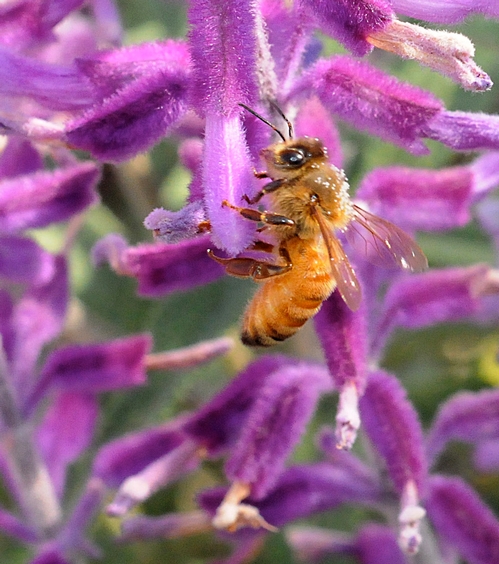It’s raining in northern California like the proverbial cats and dogs--and all the more reason to think of vacations.
Extension apiculturist Eric Mussen, member of the UC Davis Department of Entomology faculty, received a query last week from a family planning a camping trip to a public park in the Midwest.
A daughter is allergic to bee stings, so the family wanted to know two things:
1. Is there any way to find out what a bee population is in a specific area?
2. How can we avoid bee stings?
His answers are informative:
Is there any way to find out what a bee population is in a specific area?
Usually, the only records that are kept deal with the number of colonies registered by the beekeepers in a state once a year. If the beekeepers are commercial beekeepers, they are likely to move the colonies around for purposes of crop pollination or producing honey crops. Unless you knew all the beekeepers and their patterns of operation, there is no way to know where the colonies are.
If this is a good honey producing area, beekeepers might be moving their bees into it. You could call the park (if it is one) and see if they allow beekeeping on the park grounds.
Even if they don't, if there is good bee forage in the area (nectar and pollen), some honey bees are apt to be living around the area in "feral" colonies--not managed by anyone.
How can we avoid bee stings? Best preventative measures?
Honey bees do not tend to sting anything very far from the nesting location, unless you happen to step on one, etc. They are busy collecting water, nectar, pollens, or propolis (plant resins they use to glue things in the hive.) If something comes near the nesting location, and the bees respond to the approaching threat, then there might be some stinging.
What are the best preventative measures? This pertains to wasps, too, which sting more people in the woods than honey bees ever do. Keep your eyes open for "directed" flight by insects in an out of a specific spot. That is likely to be the nest entrance. Keep away from there.
If bees or wasps come flying out toward you, don't swing at them or try to blow them away from your face. You'll get stung immediately. If you are not yet stung, just stand very still for a moment, then ease yourself out of the area with no flailing or swinging of the arms, etc.
Put a lot of distance between you and the nest without running.
If they are all over you and stinging, then run first and work on the stings later. Honey bee stings stick in your flesh and give off "alarm pheromone," which leads to more stings in the same place. You do not want to continue to be a target.
If stung, look for the sting when you get a chance. If it is honey bees, the sting will be there. Scrape it off with a finger nail, before all the venom is pumped into the skin.
Honey bees are attracted more to yellow and blue than to other colors. Honey bees treat red and black as black. Black is bad if bees are stinging in the area. Pastel and white colors usually are best around bees.
Honey bees are attracted to odors reminiscent of lemon and are shocked by the smell of bananas--just like their alarm odor. (The aroma of bananas is similar to the scent of a bee's alarm pheromone.)
Final thought, even if there are bee hives or nests around, hardly anyone ever gets stung by them. They do their thing and you do yours, and there should not be any conflict under normal circumstances.
***For more information on bee stings, read the bee sting advice that appears in his newsletter, from the UC Apiaries, a publication Mussen launched in 1976. He also writes the equally informative Bee Briefs. These publications are archived on the UC Davis Department of Entomology Web site.
Attached Images:

Flight of the Honey Bee

Foraging